In June, the city spent $122 million to purchase 14 former cluster site buildings, turning them over to nonprofit organizations to fix up and operate as permanent housing. The organizations have their work cut out for them: There were more than 1,100 open Housing Preservation and Development (HPD) violations across the portfolio at the time of purchase.
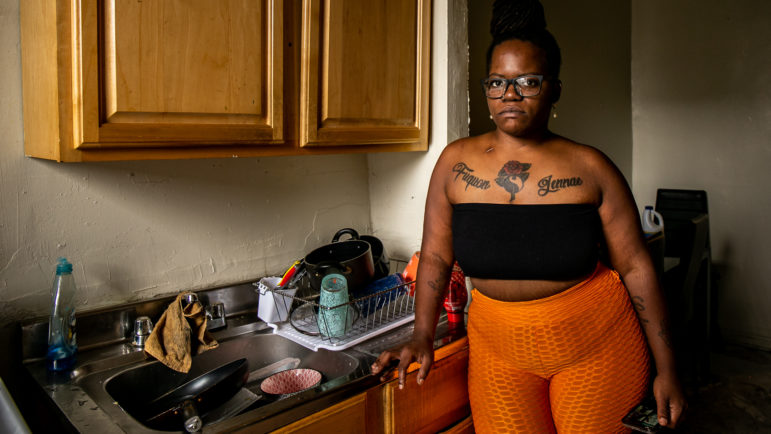
Latima Haynes in the kitchen of her sister’s apartment at 2344 Davidson Ave., a former cluster housing site in the Bronx. 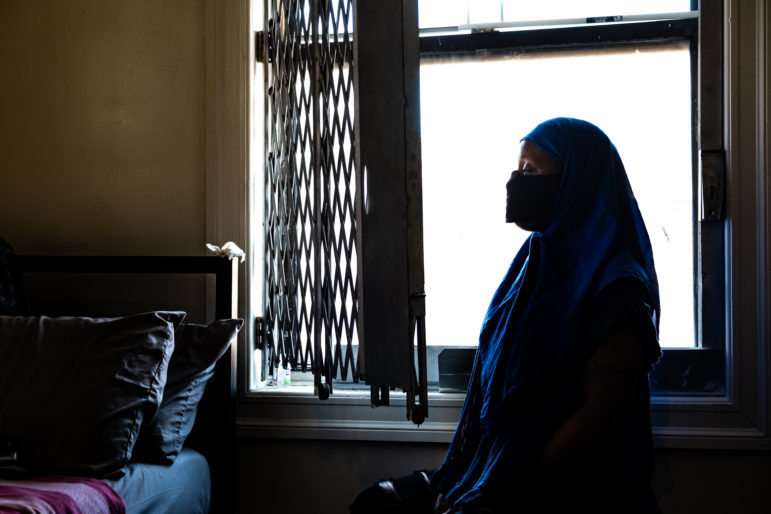
Tee Edwards and her teenage daughter moved from a Manhattan shelter into a Bronx cluster site apartment. 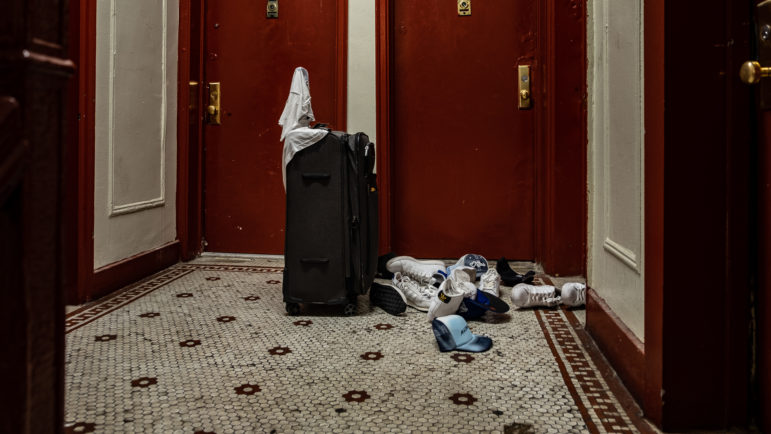
Scenes from a former cluster site apartment building located at 2290 Davidson Ave in the Bronx. 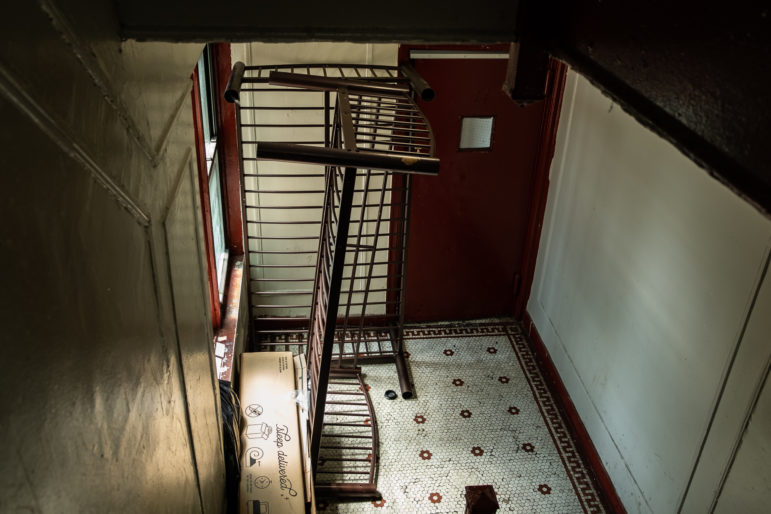
Scenes from a former cluster site apartment building located at 2290 Davidson Ave. in the Bronx. 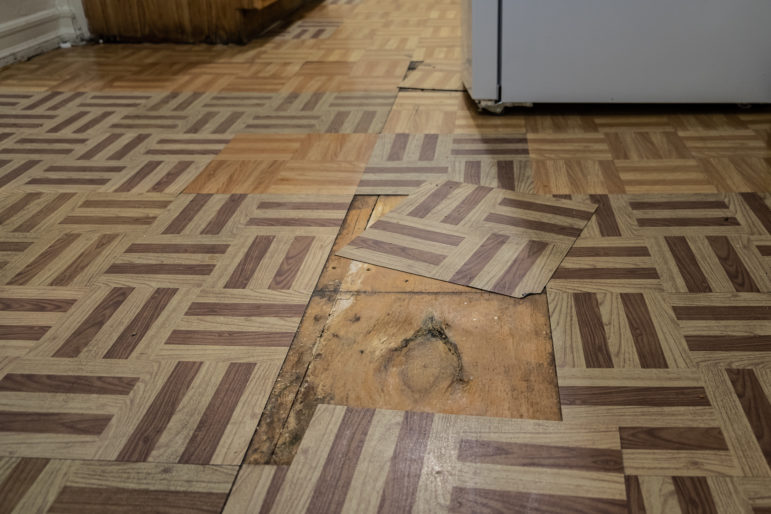
Scenes from a former cluster site apartment building located at 2290 Davidson Ave in the Bronx.
Tee Edwards had to pay the super $60 to install a lock on her front door the day she and her teenage daughter moved from a Manhattan shelter into a Bronx cluster site apartment. Three months later, the unit has been converted to permanent housing, but the clasp on the fire escape window is still broken and the hallway garbage continues to pile up, leaking juices onto the stairway landings.
A floor below, Carcynthia Salisbury said she worries about the people who come in through the unlocked entrance and use drugs in the hallways. There’s another problem, she said: Hurricane Ida poured torrents of water into the building, leading to a mildew stench behind the walls, she said.
A few hundred feet down at another building on Davidson Avenue, Latarsha Haynes’ new apartment has no smoke detector and the oven doesn’t work. The shower trickles, the windows are smeared with crud and the mailboxes are falling off the wall in the lobby—just like they were when she moved in in May.
“It’s unsettling. It’s just dirty,” said Haynes, a mother and former 311 operator who left her job to recover from back surgery. “I appreciate having a place, but I’d appreciate it if it were livable.”
The three women live in buildings owned for years by a network of opaque LLCs that rented them out to the city as “cluster site” apartments—temporary shelters for homeless families inside private residential properties—since 2000. In June, the city bought the 14-site portfolio for $122 million from the LLCs, all linked to Brooklyn-based real estate veterans Joseph Friedman and Eugene “Sol” Gross, and turned the buildings over to nonprofit organizations to fix up and operate as permanent housing.
The organizations have their work cut out for them: There were more than 1,100 open Housing Preservation and Development (HPD) violations across the 14 buildings at the time of purchase.
“We are responding to a lot of emergencies to make sure things are safe,” said John Reilly, the executive director at Fordham-Bedford Housing Corporation, which took over three of the buildings, including both properties on Davidson Avenue. “The level of disrepair in some of the apartments is requiring a lot of attention to get them to a certain standard. Really they were uninhabitable.”
Tenants on Davidson Avenue and a third site on Walton Avenue agree.
“There are leaks everywhere. It’s a slum. The worst of the worst,” said Lakeysha Noel, who said she has lived for about 20 years at 2290 Davidson Ave., in one of the few units that the previous owners did not rent out as a cluster site.
After walking through the unlocked front entrance, Noel pointed out another building across the street that is also operated by Fordham-Bedford. It’s cleaner and safer, she said, giving her cause for optimism.
“The new landlords bought it, so hopefully things get better,” she said.
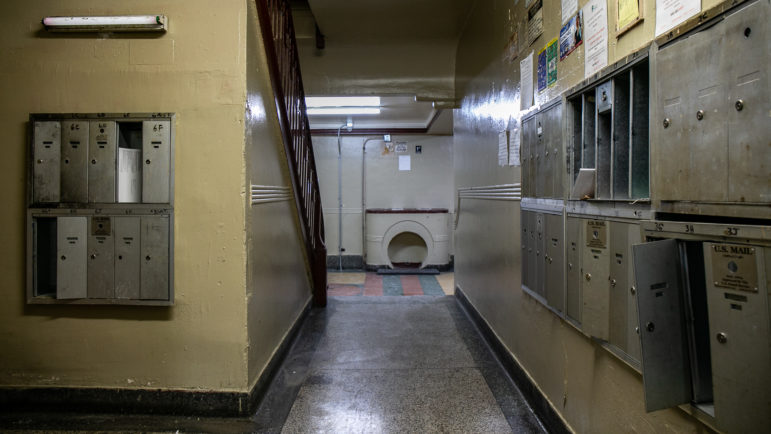
Broken mailboxes at 2344 Davidson Ave a former cluster housing site in the University Heights neighborhood of the Bronx 
A first floor space undergoing renovation at 2344 Davidson Ave. 
Missing Carbon monoxide and smoke alarm in an apartment at 2344 Davidson Ave. 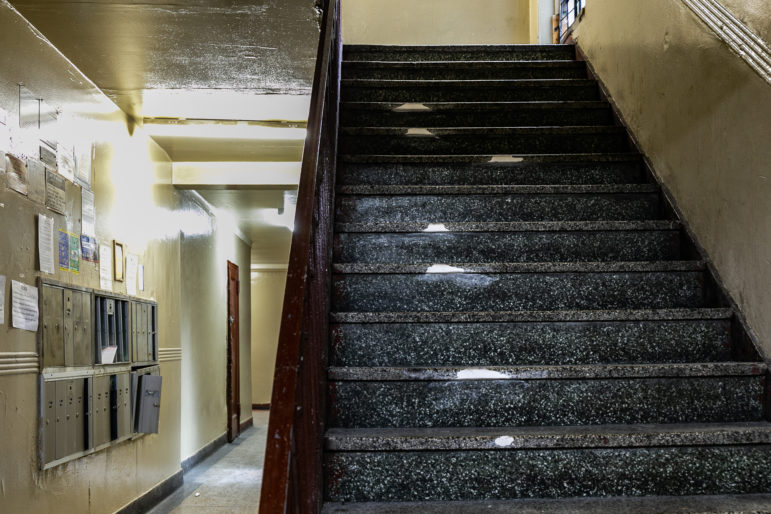
Signs of repair work at former cluster housing site in the University Heights neighborhood of the Bronx. 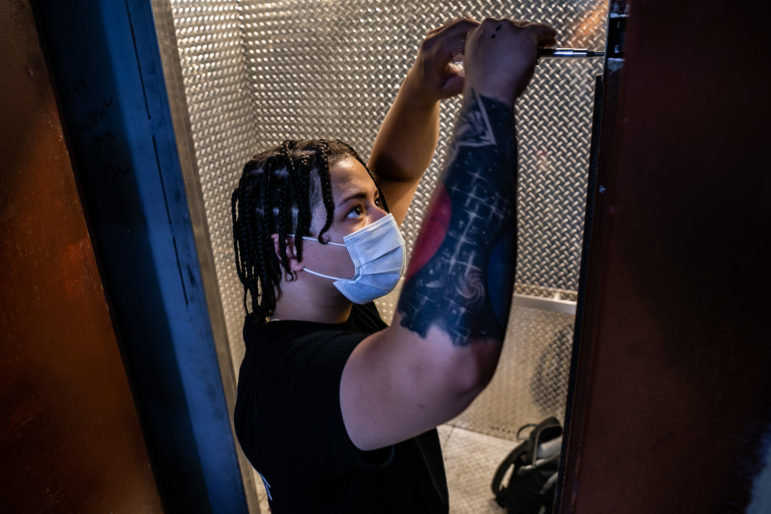
William Polanco of Innercity Elevator Corporation repairing the elevator at 2344 Davidson Ave. 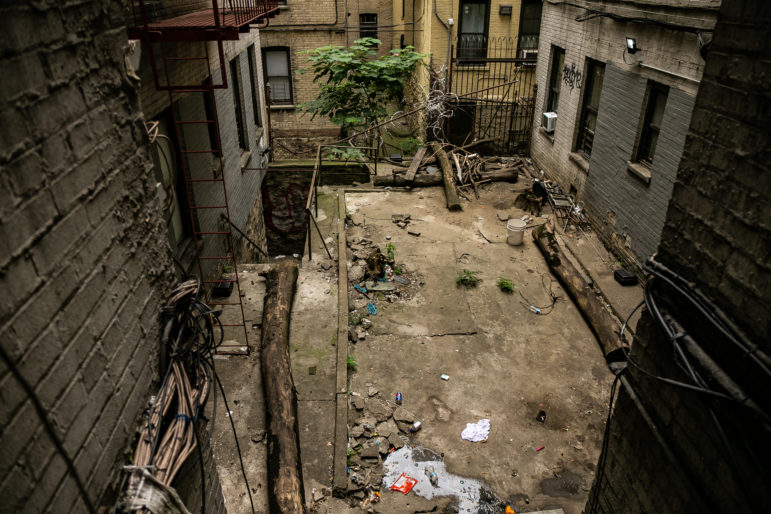
The backyard at 2344 Davidson Ave.
Cutting ties with cluster owners
Homeless rights advocates have praised the 14-building purchase. For years, organizers from Picture the Homeless and other groups have pushed the city to end the use of cluster sites and turn the units into permanent homes.
The cluster program, first started by Mayor Rudolph Giuliani, has cost the city hundreds of millions of dollars, provided some of New York City’s most dangerous accommodations for families with children and incentivized owners to drive out rent-stabilized tenants in order to cash in on the homelessness crisis.
Under a unique city rule, New Yorkers have a right to shelter, but for two decades, there were not enough municipal accommodations to house the swelling homeless population. Renting units in private residential buildings served as a relatively quick and flexible way for the city to make space—even if it meant dealing with negligent owners in subpar conditions.
The new nonprofit management companies, each paired with a social service provider, are much better suited to ensure safe conditions, said Joshua Goldfein, a senior housing attorney at Legal Aid who has long worked on issues related to cluster site shelters.
“From the perspective of the tenants, they’re in a much better position if the units they’re living in that had been rented on a daily basis by the city from bad landlords are now going to be controlled by nonprofits,” Goldfein said.
The city has now nearly phased out cluster site shelters, eliminating 95 percent of the 3,650 units that were used during the program’s January 2016 peak. The Department of Social Services (DSS), which includes the Department of Homeless Services (DHS), says the city will meet Mayor Bill de Blasio’s goal of completely ending the program by the end of the year.
The 14 buildings purchased in June account for 777 permanently affordable housing units, including more than 550 specifically for formerly homeless families. DHS says the apartments set aside for the formerly homeless will house more than 1,500 New Yorkers — a significant chunk of the declining population of families living in city shelters. There were 8,341 families with children staying in DHS shelters on Sept. 13, according to the most recent census report. Though still high, the family shelter population has reached its lowest average rate in nine years.
“Through the innovative strategy of converting former cluster units to permanent housing as part of our promise to end the 21-year-old cluster shelter program once and for all this year, we have already provided permanent housing to more than 1,700 New Yorkers in need, with that housing operated by experienced, locally-based affordable housing developers, who acquired the cluster buildings in their entirety,” said DSS Commissioner Steve Banks in a statement. “These bold transactions are crucial tools for addressing homelessness and finally ending the Giuliani-era cluster program.”
For now, however, many of the problems overseen by the previous property owners persist. Some tenants who spoke to City Limits say they fear that they unwittingly moved into units that simply replicate the worst problems of the shelter system.
A woman named Natasha, who asked not to publish her full name because she is a survivor of domestic violence, said she moved into a building on Walton Avenue in March, when it was still a cluster site, and went months without a stove. She shared videos of water pouring out of the pipe under her sink in July.
The building is now run by Bowery Residents Committee (BRC), which did not respond to requests for comment. A DHS spokesperson said the transactions include a long-term rehab phase with city support and funding.
Homeless rights advocates caution against framing the cluster flips as a boon for bad landlords subsidized for years during the city’s homelessness crisis. The imperative is to end the program once and for all, even if it means the de Blasio Administration has to hold its nose and close a deal to buy the sites from property owners who have racked up thousands of violations.
Still, some of the residents interviewed for this story questioned why the property owners maintained such miserable conditions while receiving so much money from the city.
“Somehow, for this garbage can, they [the city] were still paying $3,000 a month?” Natasha asked.
“They kept things just good enough that it’s inhabitable,” added Haynes, who lives with her 12-year-old daughter.
City Limits attempted to contact Friedman, Gross and various associates listed on property records for the 14 buildings. Neither man answered their phones or returned multiple messages.
A representative for Gross, based at a Brooklyn address where all the LLCs are incorporated, said he was not at the office Monday and would not discuss the derelict conditions. “Unfortunately, we’re not going to let you know that information,” the representative said, before hanging up the phone.
The pair have a history of operating dangerous and derelict buildings rented out to the city for shelter use.
They once ran a company called Pilgrim Realty, which managed 59 cluster sites accounting for nearly 3,000 open HPD violations in 2010, according to a shelter audit by then-Comptroller John Liu’s office.
Liu’s team investigated six of the firm’s sites—including the “Icahn Cluster” once run by billionaire Carl Icahn’s organization Children’s Rescue Fund—and found “numerous hazardous and unsanitary conditions at all the facilities.” The 65-unit Icahn Cluster building, which spans 1173 to 1177 Walton Ave., was included in the portfolio sold to the city in June.
An investigation by Liu’s predecessor a year earlier found similar conditions at Pilgrim-owned sites in the Bronx, including a vermin infestation at the Icahn Cluster.
“It is totally unacceptable that families in need are living in unsafe and unsanitary conditions under the city’s watch,” said then-Comptroller Bill Thompson in 2009.
The individual LLCs that owned the properties are all incorporated at a squat commercial building at 314 McDonald Ave. in Kensington, the site of “Brooklyn Beauty Foot Rub” and a shuttered laundromat. At least 20 other buildings around the city — including others used as shelters and at least one cited for an illegal basement conversion — are also owned by LLCs based at the same address.
City Limits visited the building on Aug. 13 and entered an unlocked door that led to a brown-carpeted staircase, where fruit flies hovered and paint chipped off the walls—conditions that resembled the Bronx residences.
As a City Limits reporter and photographer approached the second floor, a woman cracked open a door and threatened to call the police. She then locked the entrance door and cursed through the intercom.
She declined to discuss the buildings linked to her office.
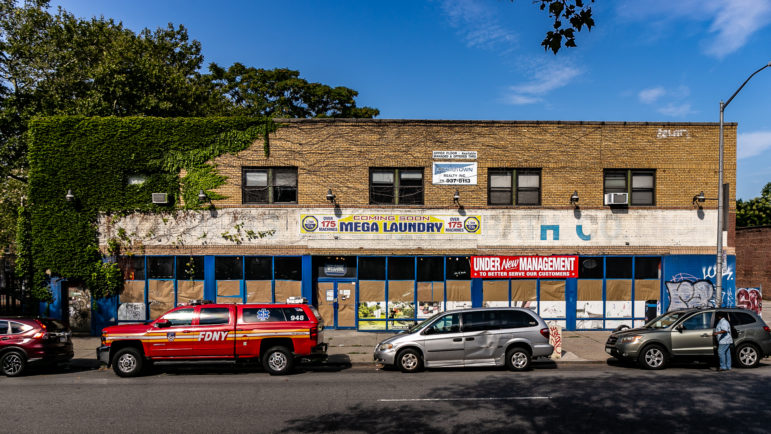
Adi Talwar
314 McDonald Ave, Brooklyn, NY 11218Gradual improvements
The approaching end of the cluster program marks a new chapter for hundreds of families who now have permanent housing. They just hope the city and the nonprofit management companies will speed up the needed renovations.
An official from HPD said the timeframe, scope and cost of renovations will vary depending on each building and that the five organizations that took them over are still determining the scope of work.
Goldfein said organizations tapped to manage the former cluster buildings often inherit a tangle of problems to address on a nonprofit’s budget. He urged the city to provide more funding, since many issues can take months or years to resolve.
“A lot of the landlords who were participating in the cluster site program were not investing in maintaining the building because they had a captive market,” he said. “But in order to make the buildings successful, the city is going to have to invest in bringing them back up to code and making them livable.”
Some improvements are already underway.
When City Limits visited 2344 Davidson Ave. last month, contractors were repairing the elevator and a work crew was renovating the superintendent’s first-floor apartment.
Edwards said Monday that a security guard had begun working in the lobby at 2290 Davidson and Salisbury said she has noticed more responsive maintenance staff. “They’re trying to clean it up,” she said.
In addition to Fordham-Bedford and BRC, the buildings are run by Settlement Housing Fund, Mid-Bronx Desperadoes Community Housing Corp, and Neighborhood Renewal HDFC. None provided a response for this story, but an official from one agency, who was not authorized to speak to the media, encouraged tenants to speak out about the lingering issues.
“The conditions that the previous owners left the buildings in really are terrible, so it’s great that residents are reaching out,” the official said.
Reilly, the Fordham-Bedford director, also acknowledged tenants’ concerns and said the organization is working to untangle the various problems.
To start, they had to sort out tenant leases, he said. DHS had to issue new ones for formerly homeless tenants whose rent is paid by city housing vouchers. Fordham-Bedford next had to track down information for existing tenants because the last landlords provided little information.
“We had a big problem with leases at first,” Reilly said. “Some of the tenants who were not homeless tenants had really old leases. There was no data at all from the building.”
Back at her Davidson Avenue apartment, Haynes’ sister Latima has been helping around the house while her back heals. The family got a cat to keep away the mice and rats, a pet she couldn’t have at the shelter.
Things are better than they were at the Bronx shelter she and her daughter last lived at, she said. But that’s a pretty low bar for measuring success, she added.
“You want to be comfortable, but it’s hard in these conditions,” she said while sitting in her bedroom last month next to a dingy window. “I don’t know how this passed inspection.”
City Limits’ series on family homelessness in New York City is supported by Citizens’ Committee for Children of New York and The Family Homelessness Coalition. City Limits is solely responsible for the content and editorial direction.










7 thoughts on “‘They Were Uninhabitable’—Ex-Landlords Leave Raft of Hazards at Former Bronx Cluster Sites”
Great article and pictures that really unfortunately tell the shocking and unimaginable stories of those who experience homelessness, the past disregard for their well-being and humanity, and the absolute greed of their former landlords.
The fact that no city department is enforcing fines and laws against landlords is scandalous. If the city stepped up and collected the fines, and put that money towards building repairs, it would go a long way to make the tenants safe, achieve justice and send a strong message to other criminal landlords.
Most judges are slumlords and “city” officials pocket the money given for such help/repairs. NO one is appointed to keep tabs and check where the money goes.
Here’s a thought: HIRE homeless people to be the ones DOUBLE CHECKING the fraud that these “city officials/cops/landlords/judges” commit. Problems would get fixed fast! Corruption at every level in every city across the USA!
Very true. Not only should they be fined, but licenses taken.
I LOL’d at the fact that BRC was given contracts here. Muzzy and the rest of the BRC crew will make $ disappear into their own bank accounts.
I thought Eric Adams was going to fix this. LOL
This isn’t new and they aren’t helping . They are either leaving people in these decrepit conditions, or relocating them under the guise of renovations, sending them to even far worse conditions. It’s not fair that they are allowed to do this and little to no resources are available for tentants to speak and say a thing . I recently got out of a shelter and was apart of the beginning process of cluster site conversion program. To a very badly maintained building runned by HELP USA . They are now after 3 years are going to Renovate but they haven’t let the tenants know. They keep collecting checks or taking money, for the tenants to be displaced and put into shelter like buildings. We aren’t in the shelter system anymore. Why the fuck are we being treated like shit? We’re paying Tenants not shelter participants….. This filth of a city cares nothing about the residents. Especially those trying to get their lives on track.
I pray things will get better for you and everyone. Seems all this is set up this way to support the court system. These non-profits are also all about profit, and many no better then the ones that profited with those cluster sites. I always say, poverty is big business for the corrupt and greedy.